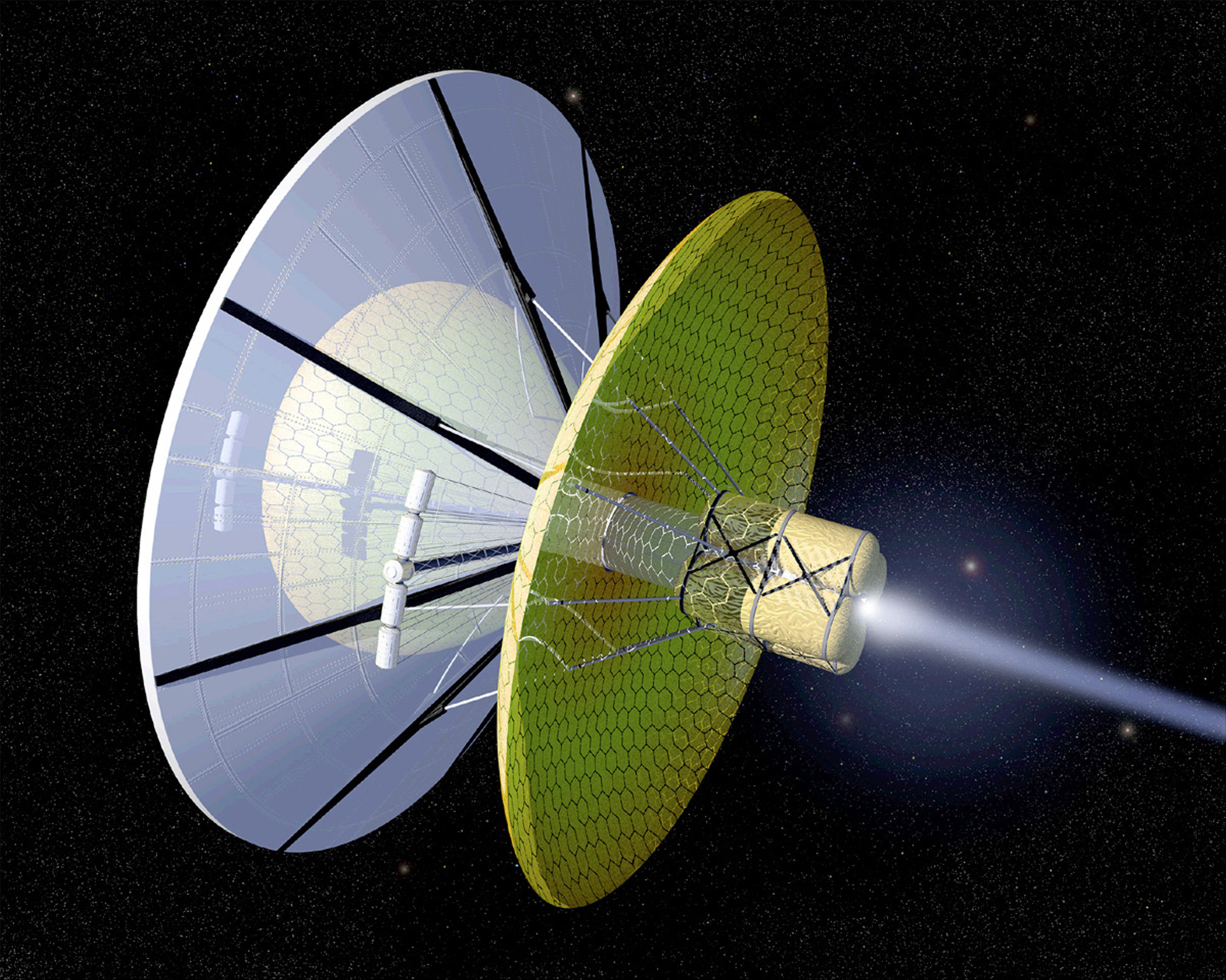
Interstellar travel
Interstellar travel is the hypothetical travel of spacecraft from one star system, solitary star, or planetary system to another. Interstellar travel is expected to prove much more difficult than interplanetary spaceflight due to the vast difference in the scale of the involved distances. Whereas the distance between any two planets in the Solar System is less than 55 astronomical units (AU), stars are typically separated by hundreds of thousands of AU, causing these distances to typically be expressed instead in light-years. Because of the vastness of these distances, non-generational interstellar travel based on known physics would need to occur at a high percentage of the speed of light; even so, travel times would be long, at least decades and perhaps millennia or longer.[1]
As of 2024, five uncrewed spacecraft, all launched and operated by the United States, have achieved the escape velocity required to leave the Solar System as part of missions to explore parts of the outer system. They will therefore continue to travel through interstellar space indefinitely. However, they will not approach another star for hundreds of thousands of years, long after they have ceased to operate (though in theory the Voyager Golden Record would be playable in the event that the spacecraft is retrieved by an extraterrestrial civilization).
The speeds required for interstellar travel in a human lifetime far exceed what current methods of space travel can provide. Even with a hypothetically perfectly efficient propulsion system, the kinetic energy corresponding to those speeds is enormous by today's standards of energy development. Moreover, collisions by spacecraft with cosmic dust and gas at such speeds would be very dangerous for both passengers and the spacecraft itself.[1]
A number of strategies have been proposed to deal with these problems, ranging from giant arks that would carry entire societies and ecosystems, to microscopic space probes. Many different spacecraft propulsion systems have been proposed to give spacecraft the required speeds, including nuclear propulsion, beam-powered propulsion, and methods based on speculative physics.[2]
Humanity would need to overcome considerable technological and economic challenges to achieve either crewed or uncrewed interstellar travel. Even the most optimistic views forecast that it will be decades before this milestone is reached. However, in spite of the challenges, a wide range of scientific benefits are expected should interstellar travel become a reality.[3]
Most interstellar travel concepts require a developed space logistics system capable of moving millions of tonnes to a construction / operating location, and most would require gigawatt-scale power for construction or power (such as Star Wisp– or Light Sail–type concepts). Such a system could grow organically if space-based solar power became a significant component of Earth's energy mix. Consumer demand for a multi-terawatt system would create the necessary multi-million ton/year logistical system.[4]
Challenges[edit]
Interstellar distances[edit]
Distances between the planets in the Solar System are often measured in astronomical units (AU), defined as the average distance between the Sun and Earth, some 1.5×108 kilometers (93 million miles). Venus, the closest planet to Earth is (at closest approach) 0.28 AU away. Neptune, the farthest planet from the Sun, is 29.8 AU away. As of January 20, 2023, Voyager 1, the farthest human-made object from Earth, is 163 AU away, exiting the Solar System at a speed of 17 km/s (0.006% of the speed of light).[5]
The closest known star, Proxima Centauri, is approximately 268,332 AU away, or over 9,000 times farther away than Neptune.
Propulsion[edit]
Rocket concepts[edit]
All rocket concepts are limited by the rocket equation, which sets the characteristic velocity available as a function of exhaust velocity and mass ratio, the ratio of initial (M0, including fuel) to final (M1, fuel depleted) mass.
Very high specific power, the ratio of thrust to total vehicle mass, is required to reach interstellar targets within sub-century time-frames.[40] Some heat transfer is inevitable, resulting in an extreme thermal load.
Thus, for interstellar rocket concepts of all technologies, a key engineering problem (seldom explicitly discussed) is limiting the heat transfer from the exhaust stream back into the vehicle.[41]
A few organisations dedicated to interstellar propulsion research and advocacy for the case exist worldwide. These are still in their infancy, but are already backed up by a membership of a wide variety of scientists, students and professionals.
Discovery of Earth-like planets[edit]
On August 24, 2016, Earth-size exoplanet Proxima Centauri b orbiting in the habitable zone of Proxima Centauri, 4.2 light-years away, was announced. This is the nearest known potentially-habitable exoplanet outside our Solar System.
In February 2017, NASA announced that its Spitzer Space Telescope had revealed seven Earth-size planets in the TRAPPIST-1 system orbiting an ultra-cool dwarf star 40 light-years away from the Solar System.[114] Three of these planets are firmly located in the habitable zone, the area around the parent star where a rocky planet is most likely to have liquid water. The discovery sets a new record for greatest number of habitable-zone planets found around a single star outside the Solar System. All of these seven planets could have liquid water – the key to life as we know it – under the right atmospheric conditions, but the chances are highest with the three in the habitable zone.